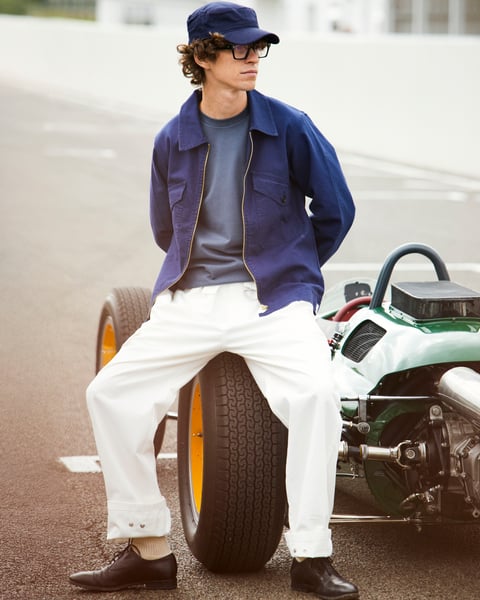The legendary Hayabusa returns
Love or hate its dramatic design, there’s no denying that the original Suzuki Hayabusa did for motorcycling what Britney did for pop music – it was nothing short of revolutionary. And now, 22 years after the original broke cover, Suzuki has revealed the new ‘Busa, and it looks, well, remarkably like it did back then.

Upon first glance it appears virtually unchanged, and only a second take reveals the sharp lines that modernise the long, sweeping silhouette. New, vertically stacked LED headlights sit between angular air intakes, while a new exhaust sweeps up towards the (still) bulbous tail. Heck, even the graphics are straight out of the noughties.
But first, let me retrace my steps and set the scene for those not as familiar with motorcycles as, say, a lightweight E-type. We were on the verge of the millennium after a decade of fervent sportsbike development, and it looked like the CBR1100XX Super Blackbird was about to see in the new era as the world’s fastest production two-wheeler. But, not so fast Honda (quite literally), for fellow Japanese manufacturer had a trick up its sleeve in the shape of the 175PS (129kW), 135Nm (100lb ft) GSX1300R – aka the Hayabusa (Japanese for the peregrine falcon). Upon launch in 1999, it immediately swooped and stole the title from its avian prey, with a top speed of between 188mph and 194mph. It was creeping towards the 200 club, but before Suzuki could achieve the elusive two-ton, fears of ever-faster, out-of-control motorcycles led to an informal 300km/h top speed limitation between European and Japanese manufacturers, with future ‘Busas limited to 186mph.
Nonetheless, it remained one of motorcycling’s greats, part of the furious, achingly aerodynamic inline-four club, remaining in production through two generations and almost two decades, until it was ultimately discontinued in 2018 (but not before almost 200,000 units had been sold).

And those fallow years since have allowed Suzuki to regroup and return with the new, third generation of the legendary hyperbike, which weighs 4kg less than its predecessor (at 264kg wet) and features no less than 550 new parts. And quite a few of those are within the heavily-revised 1,340cc, inline-four engine, with new, lighter pistons, more rigid conrods, a revised crankshaft and crankcases, a new camshaft with revised cam profiles to reduce valve lift overlap and new cam chain tensioner, an updated gearbox, new slipper clutch assembly, and new magneto.
There’s an updated fuel system, plus a new, linear ride-by-wire electronic throttle. It doesn’t inherit the GSX-R1000’s variable valve timing, but that’s not necessarily a bad thing, for it will generally be more reliable, durable and cheaper to service.
The result is an entirely new riding feel, with a flatter torque curve featuring slightly lower peak figures, and more in the mid-range – right where previous owners wanted it. Despite still being electronically limited to 186mph, it promises to be the quickest-off-the-line Hayabusa yet. It’s worth noting that this powerplant almost took on an entirely different form, with engineers toying with turbochargers, larger capacities, and even six-cylinders, before deciding to stick with the proven, potent formula.
Working in conjunction with the optimised engine is a host of new electronics, bracketed under Suzuki’s Intelligent Ride System (SIRS). The crown jewel of the comprehensive system is the Drive Mode Selector Alpha (SDMS-α) with three pre-set and three user definable user modes, plus features such as IMU-governed ABS, switchable ‘Motion Track’ traction control, power mode selector, quickshifter, launch/wheelie control and engine brake control. There is also linked brakes, cruise control, low rpm assist, hill hold control – basically everything you’d need to lead to live an easy live on two wheels. The various parameters are displayed on a colour TFT screen, which is flanked by large analogue tachometer and speedometers – a nod to the iconic clocks of the original.
While the twin-spar aluminium alloy main frame remains unchanged, it’s bookended by a lighter subframe, a new setup of the fully adjustable front and rear suspension and new seven-spoke wheels, with bigger 320mm discs up front and Brembo Stylema calipers. The result is improved ergonomics, with the bars 12mm closer to the rider for better connection with the front wheel.
It will available from March 2021, costing from £16,499. And while it may not be as revolutionary as the original, if it’s a patch on its predecessor, the new Hayabusa will soon have a cult following and a series of speed records to its name.
Motorcycle
new motorcycle
Suzuki
Hayabusa
2021
GSX1300R












